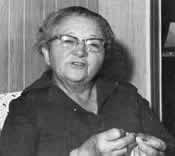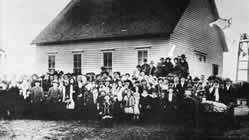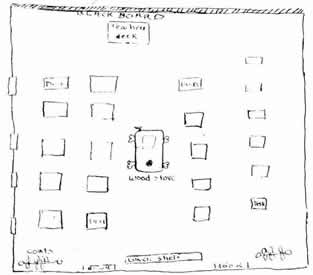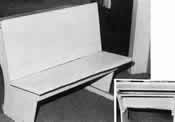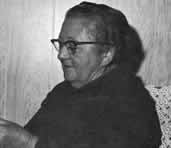 |
Volume I, No. 1, Fall 1973 |
GO ASK LOIS
To help us with our research on country schools in the early 1900's, we visited Lois Roper Beard.
She is very interested in schools and has researched and written about most of the rural schools in
and around this area. Her schooling may have been more precious to her than it is to us because
an eighth grade education was all that was available to her.
Young people like us are drawn to her friendliness and willingness to help. Whenever we need
some information or advice, someone just says, "Go ask Lois."
So we asked Lois, and this is her reply ....one person's experience in one school in the early 1900's.
Could you describe a typical day when you went to school?
A typical day at Morgan, the country school I attended, was varied, of course. We packed our lunch, unless we were close enough like I was to go home for lunch in pretty weather, and started out to school as early as we had the chores done. We played ball or games of some kind until books took up and we came in. We lined up outside according to where we were seated. That way it was very easy to find the seat. The one that was sitting in the front seat was the one that was ahead on that side next to that door. We marched in after lining up at the doors. That was a very effective way to get into the school and out without a lot of confusion, running, scuffling, shoving, pushing, and pulling. It was a lot nicer to march in and to march out and we almost always did that.
Usually we had an opening devotional program. We would sometimes sing, and many times then the teacher would read a passage From the Bible. Then we got into our regular studies and started out with each grade bering their turn at having their classes, and while the other ones were having their classes, then we had the study periods. When the teacher was ready for the children to recite, she would say, "The first grade rise, and pass." They marched to the front of the building and sat on the recitation bench. She read for them or had them to read for her if they were at that stage yet. For their arithmetic, they went to the board, and then they were dismissed and went back to their seat after about fifteen minutes. Then the second grade would have their class and the pupils all came to the front just the same as the first grade did. And all that time in the same room all the other classes were studying.
Wasn't there a lot of commotion with all that going on?
[18]
It was quite confusing if you didn't have order. Because if the boys got a little bit rowdy and began to kid or throw paper wads or something like that, you know, it was a little bit confusing. I've seen a few teachers that I have had that were not too good to keep order. I've had to take books home a many time to get my lessons because of the confusion. But I've had lots of others who kept good order and you could sit and just blot out the class that was reciting and study---do a good job of it.
Then did you have recess?
Yes. We very carefully got our books put away before our morning, recess and marched out. We had meager playground equipment.
If the older ones had a ball bat, the little ones had a board or a bat that was broken off. Sometimes we wouldn't play ball. We would play action games like Fox and Goose, Chase the Fox, or if it got too bad, we stayed in the house and played games inside like Hull Gull.
Then after recess?
After recess we usually had spelling. Now that's a thing that the teachers all stressed .... ---spelling. And I was almost always the head in headmarks. I had one girl in my growing up that we would just almost go from head to foot. Every time it came our time we didn't miss a word. We tied a lot of times in the headmarks that we'd get. We always got a prize for the one with the most headmarks.
Could you tell us a little bit about these headmarks?
You don't know how it went? We didn't have our words written down like I think they do nowadays. When you have a spelling lesson you have to write the words out, is that right? Well, we didn't. We all just went to our class and stood while the teacher gave out the words. If one missed a word, the one below was given the chance to spell it. If she got it right she went ahead of the one before her. If one didn't miss a word during class, why, it just came their time to get a headmark. The next day they went to the foot of the class again to work back up.
Well, this headmarking, was it kind of like ciphering?
Yes, a little bit. Only that the teacher kept a record of it, you see, to see how many headmarks you got in the quarter.
You got a headmark every time you spelled...?
Every time you went from one end to the other. If you went from the bottom of the class to the head of the class, and you had to if you got through that day, you had to start back from the bottom and go back up again. Each time you went out from the head to the foot then you had a headmark.
There would be just one each day though, wouldn't there be?
Oh no! You couldn't even get a headmark each day. You had to work your way from the bottom to the top of the class. When you got to the top and stayed there without missing any word, the next day you went back to the bottom. You had to turn everyone down, you see. But as a rule, there was somebody missing a word. I've seen some children that wouldn't ever get a headmark unless there were just accidentally some of the good ones out or missing.
You didn't have any list to study From?
Yes, oh yes, we had a list of words. We studied them faithfully to be sure that we could get them everyone. But we didn't write them down like you do. You see, we just had to spell them orally. It was just like a spelling match everyday. Only it was just your class instead of the whole school.
What about the lunch hour?
Then we had our noon recess. We haven't told yet about the dinners. The dinner buckets that we had usually had a whole family in one bucket, like a milk buckett a twelve quart pail or something. If there was one girl or one boy sometimes they'd have a little syrup bucket with a tight-fitted !id. Lunches were usually just the things that were left from breakfast and maybe once in a while there'd be a piece of cake--but not always. But there'd be bread and meats and maybe a boiled egg and molasses. Now I've seen bread and molasses a many a time molasses and butter mixed up together in a little jar and then bread. The boys would sometimes eat out on the woodpile, where the wood was stacked along. On a real cold day they all ate inside, but the girls usually ate in if their dinners were separate. It was never a big thing for the lunches to be packed because it was usually the same things that they had left over from breakfast. Biscuits and whatever it was. No light bread.
[19]
How would they wrap the food up?
Put a tea towel or a little white cloth in the bottom and then bring it over the top. They had to carry them pretty careful, but if it was a bucket why then the lid went down to hold the food in.
Then whenever they got to school, what did they do with their dinners?
They put them right back between the doors. It was a row of shelves that went up and of course, the little kids couldn't reach the buckets.
How long did you have to eat your lunch?
We had an hour to play and eat our lunch at the noon hour, The ones that sometimes gobbled their food got to playing before the others did. Sometimes I've seen some eat their lunch all up before noon.
And then what did you do after noon?
After noon we had other classes and after the last recess we usually had our arithmetic. After that was getting ready for the closing and bringing in the flag and marching out just like we always marched in. We walked home regardless if it was a half a mile or if it was four miles.
Could you tell us a little about the dress code ?
When I think back over our school days, it's been a long time, and there has been a lot of changes made in the dress as well as the schools. We're very fortunate now to be more plainly dressed, not so bundled up. We didn't have much school in warm weather. Boys of that day and time would wear heavy shoes, Lot of times they would have metal tips on the toes--you've heard of brass-toed shoes? That's what they were. That was to keep them from wearing out so fast. Then they would wear heavy socks. Sometimes they would be home-knitted of carpet twine. I have worn them that way myself. They wore heavy long underwear, usually one-piece, knitted underwear, sometimes fleece-lined. They were really warm. They wore caps with ear flaps that let down because it was cold to travel and sometimes they would wear a sheepskin coat over their sweater and shirt and underwear, and a lot of times in cold weather I've seen boys wear two pairs of pants. Not always did they have overalls because of the fact that it was cheaper for mothers to make their pants. They weren't as fancy as the ones that were bought, but many a child wore the homemade trousers. If they were fortunate enough I have seen them wear overalls or coveralls over them.
What were the homemade pants made of?
Well, usually they would make them out of denim and ducking, they called it. It was a heavier material than the denim.
What about the girls?
Usually we had one dress that was left from the year before that we wore to school.

[20]
We had a Sunday dress and then we had a school dress. We had aprons or pinafores, as we call them now, with long sleeves, buttoned down the back, a little belt in the back. They were real cute. We had a couple of those; we'd wash one, wear it one week and wear the other one the next week. But the dresses we kept very carefully clean and pressed and we'd wear one dress for a long time. The girls wore long-handled underwear, too. They wore long hose that came way up above the knees with their high shoes laced or buttoned. They wore black or navy blue bloomers. They had elastic at the knees that bloused and if you weren't very careful and your dress wasn't long enough, those bloomers would show, and oh my, how the boys did torment the girls over the bloomers showing.
That was funny.
What kinds of hats and coats did they wear in the wintertime?
As a rule we wore the coat that we were about to outgrow or one that's been handed down from a sister that was older. We wore caps that were good and warm, sometimes with a long tassel on the bottom that came way down and wrapped around the neck. They were knitted and would hang clear down to the bottom of the coat and then wrap around the neck as a scarf. They were pretty things. I wouldn't mind to wear one now.
What colors were the most popular?
We didn't have too many bright colors then, dark brown, black, navy blue. They were more substantial, would last longer we thought.
Were boys clothes the same way?
Yes, yes, they had no bright colors at all, the boys didn't. If we girls had anything it was red. I wore quite a lot of red dresses. I remember one little red coat when I was small, but as a rule they were more durable colors.
Morgan School Christmas Day, about 1910. Lois Ts indicated by the arrow.
[21]
As far as discipline is concerned, how did your teachers punish?
Well, that depended upon the teacher. Sometimes the teacher was kind and more considerate of the boys and girls and they could keep order without too much punishment, but sometimes we had teachers who were rough on the children and they used a great big stick.
Did they ever keep them in from recess or something like that?
Yes, and that was one of the greatest punishments when boys and girls could not go out to play at the recess and noon hour.
What if the student didn't go to school very much and didn't finish his book?
Well, he just didn't pass. He had to stay in the same grade. But that didn't happen too many times. Children in that day and time, I think, were maybe more conscious about going every day than they are now, because there was an incentive to want to go every day. We had real nice little certificates for perfect attendance and then usually the teacher would give each one who had a perfect attendance a dollar. And that dollar looked like a cartwheel then, you know.
Could you give us a description of the schools?
There was just one room, you know. There was a row of shelves for our dinner pails and the teacher's desk was up in front with the blackboard behind. There was a library--very small. On top of that's where the switches were kept. The stove was in the middle of the building. Then there was four rows of desks.What sort of desks did you have?
The desks were in rows with the little ones on one side and the big ones on the other. At first the desks were homemade by the directors or patrons of the district. I have one that my husband used when he went to school. It is very well preserved and I appreciate having it.
Did two students sit side by side on them?
They were double and sometimes we'd put the little ones in between two big ones. Usually we had to have two pupils study off of one book.
In the winter you said there was a heating stove right out in the middle of the room. Who took care of this?
Usually the largest boy in the community was the janitor. Sometimes it was a girl but not often. They usually had two janitors if the girl did the sweeping, then a boy would come and build the fires of a morning and the big boys would carry in the wood. It didn't always have to be the janitor that did it, but it was the bigger boys.
[22]
Did they get paid for this?
I did the sweeping of the schoolhouse for several years in my schooldays and was paid $2 a month, and sometimes the boy who did the fires would get 50¢ a month for building the Fires. So he wasn't paid very high. He had to get there early to build the fire to get it to heat up the house.
Then was he in charge of getting all the wood ?
Oh no. The directors in the school board meeting would let out the wood contract. The person who took that contract would bring the cordwood and put it on the schoolground. There was never any problem about the wood.
Did you have to buy all your books and supplies ?
Yes, we did and that was the one thing that was handed down, was our books from one grade to the other. I don't remember ever having a new book when I was in school. The oldest ones handed them down. We would have our readers, arithmetic, our geography, our language book, agriculture, and spelling. There was always families with From six to eight and from ten to twelve children and sometimes the books get pretty dog-eared before the year was over. The children went through them all.
What kind of paper did you write on?
We had tablets, the main one I can remember was Big Chief, I believe it was an Indian head on the front of it--a big, old wide, rough paper. It wasn't really good writing paper but we were tickled to get them. We saved every scrap. We used slates to practice on.
What were the books you had?
There was a book for the first grade and on through. The first grade we only had a primer. And then as we went on, we had little spelling words in the second grade. We didn't have a separate spelling book at all until we got about to the fourth grade and then we had a separate spelling book and arithmetic book. But as a rule, the first, second and possibly the third had all the problems and words in the same book.
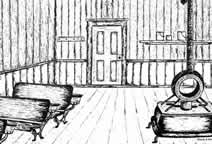
[23]
Can you tell us about the restrooms?
Well, did you ever see an outside privy? That's the name that we used for it, oh my, the privy. Yes, one was built close to the cemetery over here at our school for the girls and the boys' was a way down in the corner. Sometimes you'd see a child, especially the little ones, who came to school and they'd want to go to the toilet. They would hold up their hand and wave it and wave it until the teacher would say, "All right, Jay," we'll just use your name, and, "May I be excused?" and the teacher would nod yes, and they'd run on. Of course she kept an eye on that window toward that privy to see if they were outside playing or if they were really in earnest. Sometimes the little ones would slip out to play and if you didn't watch it there'd be two or three out at the same time. They'd really be having a picnic outside. Then's when the teacher would get a little bit strict with them and say, "Now I believe you can wait till recess." Sometimes that was a little bit hard on the child.
Did they have people go down to sweep them out?
Oh no. They never thought of that. Never entered their mind and they didn't have such a thing as toilet paper--somebody brought a cata-logo That was all there was to it. It was a very simple process keeping them clean.
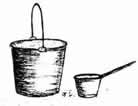
Could you tell us a little about the teachers and how they had to go to school?
The teachers when I started to school were usually the ones who had completed the eight grades, maybe went to school a year or two after that and then took the examination to get the third-grade certificate. They didn't have to have any further than just the eighth grade, if they could pass the examination. Most of them usually after they had passed the examinations for a few years would save enough money to go to college for maybe three months in the summertime and eventually could get a second-grade certificate. Maybe when they had gone a second summer they could pass the examination to get a first-grade certificate. We didn't have too many teachers when I was going that had more than a second-grade certificate. As the times progressed and the teachers began to go to college then we had more first-grade teachers. I don't know that they were any more successful, I couldn't say that. I think sometimes a teacher is born, not always made, the same as with anything else, but of course, it gave them more valuable information to pass on to help the children, but as far as the teaching ability was concerned, we've had lots of eighth graders that were wonderful teachers and they could teach as well then as was required.
Could you explain to us a little bit about the certificate? Was the difference between the different grade certificates that you took harder tests?
The tests were practically the same but it was according to the grades they made. If they made what we would class an "E", that would come under a first-grade certificate. And then as they fell down, that would be a second-grade and on down. The lowest grade to be passing for a teacher would be the third-grade.
You are saying that they didn't even go to high school? They got their certificate right out of grade school?
There wasn't when I can remember any of the teachers that went to teaching in the country schools that were high school students.
[24]
How would they go to college? They would have to have high school first, wouldn't they?
They didn't have high school. They went to what they called a normal school. They would go through the summertime to the Springfield Normal. They had a normal school at Conway for several years, and also at Russ and at Competition. (Nearby villages not more than 10 miles away.) The pupils would go there who wanted to be teachers, or who were already teachers would go there and take whatever amount of work they could have, maybe it was three months. Sometimes they went on through and missed a year of teaching and had a six months term of normal work. It wasn't like college is now. The Springfield Normal was eventually the teachers college and now it's known as Southwest Missouri State University.
How much were the teachers paid?
About $25 For three months teaching.
For all three months?
Twenty-five dollars for the three months and that's all the school they had that year was the three months,
Did the salary include the room and board of the teachers?
They had to pay their board. If they had to come in From out of the district they'd have to either manage their own way to go back home for their board or pay their board in the district. It wasn't very high.
Some teachers stayed with your family because you lived so close to the school. How much did they have to pay?
Now that I'm not positive. It was a very small sum, I will tell you that, and they came so close to the family that we almost Felt like they were our Family. Even before I started to school the teachers lived with us. I've been close to Morgan School all my life. After marrying, we soon moved back here near the school. In recent years I've been Fortunate enough to record the history of most of the schools in the area. The schools mean a great deal to me.

[25]
Copyright © 1981 BITTERSWEET, INC.
Next Article | Table of Contents | Other Issues
